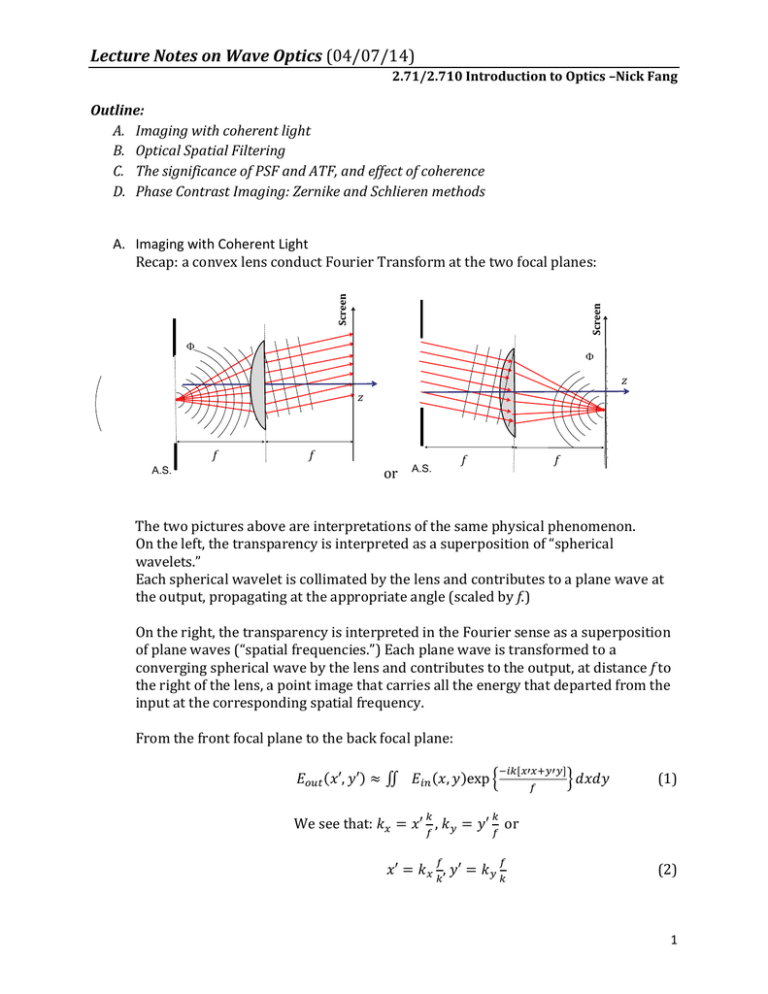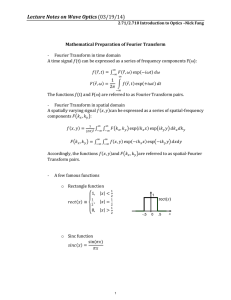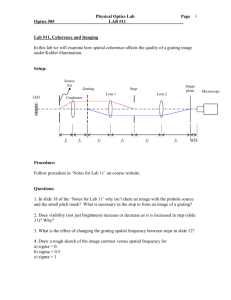
Lecture Notes on Wave Optics (04/07/14)
2.71/2.710 Introduction to Optics –Nick Fang
Outline:
A. Imaging with coherent light
B. Optical Spatial Filtering
C. The significance of PSF and ATF, and effect of coherence
D. Phase Contrast Imaging: Zernike and Schlieren methods
Screen
Screen
A. Imaging with Coherent Light
Recap: a convex lens conduct Fourier Transform at the two focal planes:
F
F
z
z
f
A.S.
f
or
f
A.S.
f
14
13
The two pictures above are interpretations of the same physical phenomenon.
On the left, the transparency is interpreted as a superposition of “spherical
wavelets.”
Each spherical wavelet is collimated by the lens and contributes to a plane wave at
the output, propagating at the appropriate angle (scaled by f.)
On the right, the transparency is interpreted in the Fourier sense as a superposition
of plane waves (“spatial frequencies.”) Each plane wave is transformed to a
converging spherical wave by the lens and contributes to the output, at distance f to
the right of the lens, a point image that carries all the energy that departed from the
input at the corresponding spatial frequency.
From the front focal plane to the back focal plane:
𝐸𝑜𝑢𝑡 (𝑥′, 𝑦′) ≈ ∬ 𝐸𝑖𝑛 (𝑥, 𝑦)exp {
𝑘
𝑘
𝑓
𝑓
−𝑖𝑘[𝑥′𝑥+𝑦′𝑦]
𝑓
} 𝑑𝑥𝑑𝑦
(1)
We see that: 𝑘𝑥 = 𝑥′ , 𝑘𝑦 = 𝑦′ or
𝑓
𝑓
𝑘
𝑘
𝑥′ = 𝑘𝑥 , 𝑦′ = 𝑘𝑦
(2)
1
Lecture Notes on Wave Optics (04/07/14)
2.71/2.710 Introduction to Optics –Nick Fang
By cascading two lenses together, we can reveal Abbe’s theory of imaging process:
image
plane
object:
decomposed into
Huygens wavelets
plane
wave
illumination
Fourier (pupil)
plane
object:
decomposed into
spatial frequencies
plane
wave
illumination
image
plane
diffraction order
comes to focus
Ideally, applying two forward Fourier transforms recovers the original function of
the object field, with a reversal in the coordinates:
𝐸𝑖𝑚𝑎𝑔𝑒 (𝑥", 𝑦") ≈ ∬ 𝐸 (𝑥′, 𝑦′)exp {
−𝑖𝑘[𝑥′𝑥"+𝑦′𝑦"]
} 𝑑𝑥′𝑑𝑦′
𝑓2
𝑓1
(3)
𝑓1
Using 𝑥′ = 𝑘𝑥 , 𝑦 ′ = 𝑘𝑦
𝑘
𝑘
𝑓
2
𝑓
𝐸𝑖𝑚𝑎𝑔𝑒 (𝑥", 𝑦") ≈ ( 1) ∬ 𝐸 (𝑥′, 𝑦′)exp {−𝑖 1 [𝑘𝑥 𝑥" + 𝑘𝑦 𝑦"]} 𝑑𝑘𝑥 𝑑𝑘𝑦
𝑘
𝑓
2
Let −
𝑓1
𝑓2
𝑥" = 𝑥, −
𝑓1
𝑓2
(4)
𝑦" = 𝑦,
(5)
𝐸𝑖𝑚𝑎𝑔𝑒 (𝑥", 𝑦") ∝ ℱ (ℱ (𝐸𝑜𝑏𝑗𝑒𝑐𝑡 (𝑥, 𝑦))) = 𝐸𝑜𝑏𝑗𝑒𝑐𝑡 (−
𝑓2
𝑓1
𝑥, −
𝑓2
𝑓1
𝑦)
(6)
Potentially, the magnification ratio 𝑀 = 𝑓2 /𝑓1 can be arbitrarily large. This however
does not mean that the microscope is able to resolve arbitrarily small objects. The
finite size of the aperture stop, and the corresponding transmission 𝐴𝑆(𝑥 ′ , 𝑦 ′ ) will
contribute to the above Fourier transforms:
𝑓
𝑓
𝐴𝑆(𝑥 ′ , 𝑦 ′ ) = 𝐴𝑆(𝑘𝑥 1 , 𝑘𝑦 1 )
(7)
𝑘
𝑘
2
Lecture Notes on Wave Optics (04/07/14)
2.71/2.710 Introduction to Optics –Nick Fang
𝐸𝑖𝑚𝑎𝑔𝑒 (𝑥", 𝑦") ≈ ℱ (𝐴𝑆(𝑘𝑥
𝐸𝑖𝑚𝑎𝑔𝑒 (𝑥", 𝑦") ≈ 𝐸𝑜𝑏𝑗𝑒𝑐𝑡 (−
𝑓2
𝑓1
𝑓1
𝑓1
, 𝑘𝑦 ) × ℱ (𝐸𝑜𝑏𝑗𝑒𝑐𝑡 (𝑥, 𝑦)))
𝑘
𝑘
𝑥, −
Note: In Goodman’s book, the term𝐴𝑆(𝑘𝑥
𝑓2
𝑓1
𝑓1
𝑘
𝑦) ⨂ℱ [𝐴𝑆 (𝑘𝑥
𝑓1
𝑘
𝑓
, 𝑘𝑦 1)]
(8)
𝑘
𝑓
, 𝑘𝑦 1 ) is called Amplitude Transfer
𝑘
𝑓
𝑓
Function(ATF), and its Fourier transform, ℱ [𝐴𝑆(𝑘𝑥 1 , 𝑘𝑦 1 )] is called Point Spread
𝑘
𝑘
Function(PSF) (since it is the spread of an ideal point source 𝛿(𝑥, 𝑦) at the image).
Worked Examples:
1) Rectangle apertures:
𝑓𝑘
𝑓1 𝑘𝑦
𝑎𝑘
𝑏𝑘
𝐴𝑇𝐹 = 𝑟𝑒𝑐𝑡 ( 1 𝑥) 𝑟𝑒𝑐𝑡(
𝑃𝑆𝐹(𝑥", 𝑦") ≈ (
𝑓1
)
(9)
2
𝑓1
𝑓
𝑓1
𝑘𝑥 ) 𝑟𝑒𝑐𝑡( 1 𝑘𝑦 )exp {−𝑖 [𝑘𝑥 𝑥" + 𝑘𝑦 𝑦"]} 𝑑𝑘𝑥 𝑑𝑘𝑦
𝑘
𝑎𝑘
𝑏𝑘
𝑓2
𝑎𝑘
𝑏𝑘
𝑃𝑆𝐹(𝑥", 𝑦") ≈ [𝑎𝑠𝑖𝑛𝑐 ( 𝑥)] [𝑏𝑠𝑖𝑛𝑐 ( 𝑦)]
𝑓1
𝑓1
) ∬ 𝑟𝑒𝑐𝑡 (
=[𝑎𝑠𝑖𝑛𝑐 (−
𝑎𝑘
𝑓2
𝑥")] [𝑏𝑠𝑖𝑛𝑐 (−
𝑏𝑘
𝑓2
𝑦")]
(10)
a/λf1
b/λf1
ATF
PSF
3
Lecture Notes on Wave Optics (04/07/14)
2.71/2.710 Introduction to Optics –Nick Fang
2) Circular apertures:
𝐴𝑇𝐹 = 𝑐𝑖𝑟𝑐 (
𝑃𝑆𝐹(𝑥", 𝑦") ≈ (
𝑓1
𝑘
2
) ∬ 𝑐𝑖𝑟𝑐 (
𝑓1
𝑅𝑘
√𝑘𝑥 2 + 𝑘𝑦 2 )
(11)
𝑓1
𝑓
√𝑘𝑥 2 + 𝑘𝑦 2 ) exp {−𝑖 1 [𝑘𝑥 𝑥" + 𝑘𝑦 𝑦"]} 𝑑𝑘𝑥 𝑑𝑘𝑦
𝑅𝑘
𝑓2
𝑃𝑆𝐹(𝑥", 𝑦") ≈ 𝑎2 𝐽𝑖𝑛𝑐 (
𝑅𝑘
√𝑥2
𝑓1
+ 𝑦2 )=𝑎2 𝐽𝑖𝑛𝑐 (
𝑅𝑘 √ 2
𝑥"
𝑓2
2
+ 𝑦" )
(12)
2R/λf1
ATF
PSF
B. Optical Spatial Filtering
Spatial Filtering is a technique to process signals in an optical way, where the
irradiance content in the Fraunhofer plane is manipulated to control the irradiance
pattern in the image plane. A digital element to provide Spatial Filtering in a
dynamical way is coined as a spatial light modulator (SLM). SLM consists of an array
of pixels, each capable of controlling the amplitude or phase of the illuminating field.
For example, liquid crystal SLMs control the amplitude and phase of the transmitted
or reflected light. Likewise, TI’s DLP SLM uses arrays of deformable micromirrors
made by MEMS technology to adjust the amplitude and phase of the reflected light.
Examples of spatial light modulators removed due to copyright restrictions.
The basic setup for optical spatial filtering is a telescopic lens system, consisting of
two lenses. Quite often, we can assume that the two lenses have the same focal
4
Lecture Notes on Wave Optics (04/07/14)
2.71/2.710 Introduction to Optics –Nick Fang
length f for simplicity. Then the distance from the object to the processed image is
4f . For this reason such a system is called the 4-F setup for spatially filtering an
image.
The following examples are typical image processing setup using various types of
spatial frequency filters:
f1
f1
f2
f2
Low pass
filter
Input
Output
Screen
(a) Low pass filter: A circular aperture in the Fourier plane will block the high
spatial frequencies and pass the low frequency ones. If the filter is an aperture
of diameter a, the cutoff frequency is given by the condition:
𝑘𝑐𝑢𝑡𝑜𝑓𝑓 =
𝑘𝑎
2𝑓1
That is, features smaller than the length scale of 2𝜆
f1
Input
f1
f2
High pass
filter
(13)
𝑓1
𝑎
is removed from the image.
f2
Output
Screen
(b) High pass filter: A circular absorbing disk in the Fourier plane does the
𝑓
opposite to low pass filter. Features larger than the length scale of 2𝜆 1 are
𝑎
removed from the image. This filter is also called a dark field filter in the
microscopy and used frequently in materials science, as it allows only light
scattered from sharp edges (such as grain boundaries) to pass through the filter.
5
Lecture Notes on Wave Optics (04/07/14)
2.71/2.710 Introduction to Optics –Nick Fang
f1
f1
f2
f2
Dot Array
Mask
Input
Output
Screen
(c) Step and Repeat operation
C. The significance of PSF and ATF
The theory of optical imaging and communication has a lot in common. The above
imaging process might be modeled with an equivalent circuit. (Such analogy has
stimulated research and development for basic operation such as multiplication,
division, differentiation, correlation, etc. The application of the optical processing
can be found in a variety of fields, such as, pattern recognition, computer aided
vision, computed tomography, and image improvement. )
Input:
E(x, y)
Element 1
Element 2
Element 3
lens,
grating,
apertures
t1(x, y)
lens,
grating,
apertures
t2(x’, y’)
lens,
grating,
apertures
Propagation or
scattering
Propagation or
scattering
h(x, x’, y, y’)
h(x’, x”, y’, y”)
The typical distance between lenses and apertures are not large to meet
Fraunhofer condition. Instead, we can use the following Fresnel
propagator:
′
′
h(x, y, x , y , z) =
exp(𝑖𝑘𝑧)
𝑧
𝑒𝑥𝑝(𝑖𝑘
2
(𝑥 ′ −𝑥) +(𝑦′ −𝑦)
2𝑧
2
)
(14)
In coherent illumination, the point spread function (PSF) describes the
response of the lens system to an impulse 𝛿(𝑥, 𝑦) at the input field. If the
6
Lecture Notes on Wave Optics (04/07/14)
2.71/2.710 Introduction to Optics –Nick Fang
system is shift-invariant, then the observed image is a sum of all the field
E(x”, y”) contributed by the spread of each point (x, y) from the object.
E(x, y)
E(x”, y”)
Under (spatially) coherent illumination, the image field is a convolution of
object field with point spread function (PSF). Correspondingly, the
Amplitude Transfer Function (ATF) is the Fourier transform of PSF:
𝐸𝑖𝑚𝑎𝑔𝑒 (𝑥", 𝑦") = 𝐸𝑜𝑏𝑗𝑒𝑐𝑡 (−
𝑓2
𝑓1
𝑥, −
𝑓2
𝑓1
𝑦) ⨂𝑃𝑆𝐹(𝑥, 𝑦)
𝐴𝑇𝐹(𝑘𝑥 , 𝑘𝑦 ) = ∫ ∫ 𝑃𝑆𝐹(𝑥, 𝑦) exp(𝑖𝑘𝑥 𝑥 + 𝑖𝑘𝑥 𝑦) 𝑑𝑥𝑑𝑦
(15)
(16)
e.g. ATF of single square aperture:
𝐴𝑇𝐹 = 𝑟𝑒𝑐𝑡 (
𝑓1 𝑘𝑦
𝑓1 𝑘𝑥
)
) 𝑟𝑒𝑐𝑡(
𝑏𝑘
𝑎𝑘
Under (spatially) incoherent illumination, the image intensity is a
convolution of object intensity with intensity of point spread function
(iPSF=|PSF|2). Correspondingly, the (complex) Optical Transfer Function
(OTF) is the Fourier transform of iPSF:
𝐼𝑖𝑚𝑎𝑔𝑒 (𝑥", 𝑦") = 𝐼𝑜𝑏𝑗𝑒𝑐𝑡 (−
𝑓2
𝑓1
𝑥, −
𝑓2
𝑓1
𝑦) ⨂|𝑃𝑆𝐹(𝑥, 𝑦)|2
𝑂𝑇𝐹(𝑘𝑥 , 𝑘𝑦 ) = ∫ ∫|𝑃𝑆𝐹(𝑥, 𝑦)|2 exp(𝑖𝑘𝑥 𝑥 + 𝑖𝑘𝑥 𝑦) 𝑑𝑥𝑑𝑦 = 𝐴𝑇𝐹 ⊗ 𝐴𝑇𝐹
(17)
(18)
e.g. OTF of single square aperture:
𝑓𝑘
𝑓𝑘
𝑎𝑘
𝑏𝑘
|𝑂𝑇𝐹| = Λ ( 1 𝑥) Λ( 1 𝑦)
(19)
7
Lecture Notes on Wave Optics (04/07/14)
2.71/2.710 Introduction to Optics –Nick Fang
DLP Projection Image
DLP Projection Image
DLP Projection Image
AERIAL IMAGE
AERIAL IMAGE
AERIAL IMAGE
0.1749
1.4051
.08855
0.0000
0.1138 mm
.05666 mm
.05666 mm
0.7026
0.1876
.09420
.00084
.00216
.05666 mm
0.1138 mm
.05666 mm
Field = ( 0.000, 0.000) Degrees
Defocusing = 0.000000 mm
RNA: 0.00
Field = ( 0.000, 0.000) Degrees
Defocusing = 0.000000 mm
RNA: 1.00
Field = ( 0.000, 0.000) Degrees
Defocusing = 0.000000 mm
RNA: 1.00
Simulated intensity pattern of a 5x5 checkerboard illuminated by a light source with different
coherence. (left)100% coherent; (middle)50% coherent; (right) non-coherent.
© Source unknown. All rights reserved. This content is excluded from our Creative
Commons license. For more information, see http://ocw.mit.edu/fairuse.
D. More specific examples on Coherent Imaging
a. Zernike Phase-Contrast Imaging
Zernike’s Phase Contrast is commonly used in biological microscopy to view
transparent objects such as cellular membranes (that would otherwise require
staining).
Let’s consider a transparent object with a small phase shift in the following form:
(20)
t(𝑥, 𝑦) = exp(𝑖𝑘(𝑛 − 1)ℎ(𝑥, 𝑦)) ≈ 1 + 𝑖𝑘(𝑛 − 1)ℎ(𝑥, 𝑦)
TOP
VIEW
thickness
h(x,y)
protrusion
(transparent)
glass plate
(transparent)
CROSS
SECTION
protrusion
phase-shifts
coherent illumination
by amount φ(x,y) =k(n-1)h(x,y)
This model is often useful for imaging
biological objects (cells, etc.)
When the transparent object is uniformly illuminated by a plane wave, the
transmitted intensity is close to unity, leaving very low contrast. The idea behind
the Zernike method starts with the observation that the unity part is the dc
component in the Fourier plane, while 𝜙(𝑥, 𝑦) = 𝑘(𝑛 − 1)ℎ(𝑥, 𝑦) represents a
spatial distribution in the Fourier spectrum.
So what if we modify one of these to prevent the cancellation? Specifically, let’s
try a 𝜋/2 phase shift of the dc component:
8
Lecture Notes on Wave Optics (04/07/14)
2.71/2.710 Introduction to Optics –Nick Fang
𝜋
𝑡(𝑥, 𝑦) = exp (𝑖 ) + 𝑖𝑘(𝑛 − 1)ℎ(𝑥, 𝑦) = 𝑖(1 + 𝑘(𝑛 − 1)ℎ(𝑥, 𝑦))
2
𝐼(𝑥, 𝑦) ∝ |t(𝑥, 𝑦)|2 = 1 + 2𝑘(𝑛 − 1)ℎ(𝑥, 𝑦) + 𝑂(ℎ2 )
(21)
(22)
Now the transmitted intensity reflects the phase information. Actually, since the
intensity with phase change is nearly linear for small phase shifts, this method
gives a direct image of the phase that is simple to interpret.
b. Schlieren Method
Wedge
Or spiral phase
plate
f1
Phase object
𝜙(𝑥)
f1
𝐸𝑖
≈
f2
f2
𝑥
𝑎 𝑒
𝑥"
𝐸𝑜𝑏𝑗𝑒𝑐𝑡 𝑥
Output
Screen
𝑡 𝑥′ ≈ 1 + 𝑖𝑘 ∆𝑛 (𝑥′ /𝑎)
Schlieren (“streaks” in German) or shadowgraph imaging is important in the
visualization of fluid flows, as it shows phase gradients of the object in a
particular direction. To elaborate that effect, let’s model the transmission
function of the phase mask (e.g. a glass wedge or spiral plate) as following:
AS(𝑥 ′ , 𝑦′) ≈ 1 + 𝑖𝑘(∆𝑛)(𝑥 ′ /𝑎)
(23)
The field transmitted through the fluid (𝑥, 𝑦) , is illuminating on the aperture:
𝐸𝑜𝑏𝑗𝑒𝑐𝑡 (𝑥, 𝑦) ∝ 𝑒𝑥𝑝[𝑖𝜙(𝑥, 𝑦)]
𝐸𝑖𝑚𝑎𝑔𝑒 (𝑥", 𝑦") ≈ ℱ (𝐴𝑆(𝑘𝑥
(24)
𝑓1
𝑓1
, 𝑘𝑦 ) × ℱ (𝐸𝑜𝑏𝑗𝑒𝑐𝑡 (𝑥, 𝑦)))
𝑘
𝑘
𝐸𝑖𝑚𝑎𝑔𝑒 (𝑥", 𝑦") ≈ ℱ ((1 + 𝑖(∆𝑛)𝑘𝑥
𝑓1
) × ℱ (𝐸𝑜𝑏𝑗𝑒𝑐𝑡 (𝑥, 𝑦)))
𝑎
𝐸𝑖𝑚𝑎𝑔𝑒 (𝑥", 𝑦") ≈ 𝐸𝑜𝑏𝑗𝑒𝑐𝑡 (𝑥, 𝑦) + (∆𝑛)
𝑓1
𝑎
ℱ (ℱ (
𝜕
𝜕𝑥
𝐸𝑜𝑏𝑗𝑒𝑐𝑡 (𝑥, 𝑦)))
(25)
9
Lecture Notes on Wave Optics (04/07/14)
2.71/2.710 Introduction to Optics –Nick Fang
𝐸𝑖𝑚𝑎𝑔𝑒 (𝑥", 𝑦") ≈ 𝐸𝑜𝑏𝑗𝑒𝑐𝑡 (𝑥, 𝑦) + (∆𝑛)
𝐸𝑖𝑚𝑎𝑔𝑒 (𝑥", 𝑦") ≈ 𝐸𝑜𝑏𝑗𝑒𝑐𝑡 (𝑥, 𝑦) [1 + 𝑖(∆𝑛)
𝑓1 𝜕
𝑎 𝜕𝑥
𝑓1 𝜕
𝑎 𝜕𝑥
𝐸𝑜𝑏𝑗𝑒𝑐𝑡 (𝑥, 𝑦)
𝜙(𝑥, 𝑦)]
(26)
(27)
Note that using a mask with phase gradient, the intensity fringes of image are
connected to the index gradient of the fluid flow! Such effect was first reported
by Hooke and Huygens, when they used a candle to heat up the air in front of an
observing lens. (see “Schlieren experiment 300 years ago”, by J. RIENITZ ,
Nature 254, 293 - 295 (27 March 1975); doi:10.1038/254293a0)
10
MIT OpenCourseWare
http://ocw.mit.edu
2SWLFV
Spring 2014
For information about citing these materials or our Terms of Use, visit: http://ocw.mit.edu/terms.





